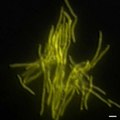Joubert syndrome is a rare genetic disorder that affects the cerebellum, an area of the brain that controls balance and coordination.
Diagnosis

The disorder is characterized by absence or underdevelopment of the cerebellar vermis and a malformed brain stem (molar tooth sign). The most common features include ataxia (lack of muscle control), hyperpnea (abnormal breathing patterns), sleep apnea, abnormal eye and tongue movements, and hypotonia. Other malformations such as extra fingers and toes, cleft lip or palate, tongue abnormalities, and seizures may also occur. There may be mild or moderate intellectual disabilities. Joubert syndrome is one of the many genetic syndromes associated with syndromic retinitis pigmentosa. The syndrome was first identified by pioneering pediatric neurologist Marie Joubert in Montreal, Canada, while working at the Montreal Neurological Institute and McGill University.
Treatment

Treatment for Joubert syndrome is symptomatic and supportive. Infant stimulation and physical, occupational,speech and hearing therapy may benefit some patients. Infants with abnormal breathing patterns should be monitored.
Prognosis

The prognosis for individuals with Joubert syndrome varies. Some patients have a mild form with minimal motor disability and good mental development, while others may have severe motor disability and moderate mental developmental delays.
Genetics

A number of mutations have been identified in individuals with Joubert syndrome (JBTS) which allowed for classification of the disorder into subtypes.
Ciliopathy

Research has revealed that a number of genetic disorders, not previously thought to be related, may indeed be related as to their root cause. Joubert syndrome is one such disease. It is a member of an emerging class of diseases called ciliopathies.
The underlying cause of the ciliopathies may be a dysfunctional molecular mechanism in the primary cilia structures of the cell, organelles which are present in many cellular types throughout the human body. The cilia defects adversely affect "numerous critical developmental signaling pathways" essential to cellular development and thus offer a plausible hypothesis for the often multi-symptom nature of a large set of syndromes and diseases.
Currently recognized ciliopathies include Joubert syndrome, primary ciliary dyskinesia (also known as Kartagener Syndrome), Bardet-Biedl syndrome, polycystic kidney disease and polycystic liver disease, nephronophthisis, Alstrom syndrome, Meckel-Gruber syndrome and some forms of retinal degeneration.
References

External links

- The Joubert Syndrome Foundation Home Page
- NINDS Joubert Syndrome Information Page
- Researchers Identify Joubert Syndrome Genes
- GeneReviews: Joubert syndrome
- University of Washington Joubert Research Program
- NCBI Joubert Syndrome
- Joubert Research Program - Seattle Research Hospital Children's Foundation
